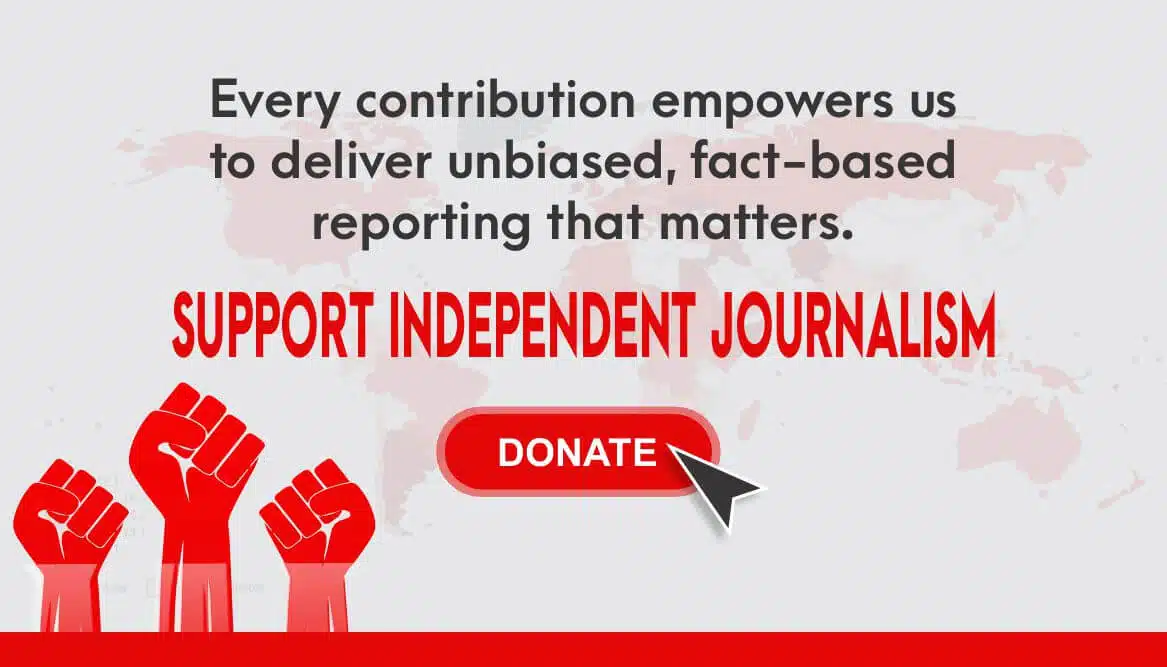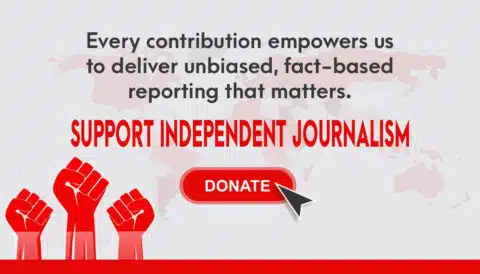In light of the barbaric Zionist aggression against the Palestinians in the Gaza Strip — genocide and ethnic cleansing — there is an urgent need to counter the Zionist propaganda that is “repeated endlessly in the media, enforced by the military, accepted without question by the world’s governments.” Israeli historian Professor Ilan Pappe’s 2017 book Ten Myths About Israel (Verso) does the job admirably. The late John Pilger described Pappe as “Israel’s bravest, most principled, most incisive historian.” How right he was.
The author looks at the facts of the Palestine-Israel issue; the myths on which Israel was founded; the strategies followed by the Zionists in managing it; and the reasons for the blatant Western bias in supporting Israeli aggression.
Most of the world’s understanding of Palestine’s history is distorted, largely because of the Israeli narrative. “Historical disinformation,” says Pappe, “even of the most recent past, can do tremendous harm.” What he calls “willful misunderstanding of history” can and does “promote oppression and protect a regime of colonization and occupation. It is not surprising, therefore, that policies of disinformation continue to the present and play an important part in perpetuating the conflict.”
Myth #1: Palestine was an empty land
That’s what the Zionists said. “A land without a people, for a people without a land,” was the claim. And yet Palestine has been inhabited by the Palestinians for centuries. “Palestine” was a Roman province, and during the Ottoman period from 1517 to 1917 it was a largely Sunni Muslim, rural society. Historian Yonatan Mendel notes that Jews made up between two and five per cent of the population before Zionism raised its ugly head.
However, according to Pappe, anyone reading official Israeli sources will come away with the idea that, “Sixteenth-century Palestine, it appears, was mainly Jewish, and the commercial lifeblood of the region was concentrated in the Jewish communities in these towns.” And that by 1800, “Palestine had become a desert… Every passing year the land became more barren, deforestation increased and farmland turned to desert.” When promoted through an official state website, adds the author, “this fabricated picture is unprecedented.”
Rather than being a desert, Palestine was a thriving Arab society about to enter the twentieth century as a modern society
Many Israeli scholars have challenged this false narrative, including David Grossman, Amnon Cohen and Yehoushua Ben-Arieh. Their research shows that, over the centuries, rather than being a desert, Palestine was a thriving Arab society about to enter the twentieth century as a modern society. The Zionist movement’s colonization turned its modernization process into a disaster for the majority of the indigenous people living there.
Myth #2: The Jews were a people without a land
According to Shlomo Sand in his book The Invention of the Jewish People, the Christian world adopted the idea of the Jews as a nation that must one day return to the Holy Land to fulfil Biblical prophecies about the Second Coming of Jesus and the end of time. Christian Zionism predated political Zionism, which turned it into a Jewish project. The Christian idea was to colonize Palestine and transform it into a Christian entity. This combination of Jewish and Christian motives fed into the issue of the 1917 Balfour Declaration by the British government. To this day, millions of Evangelical Christians in the US in particular are among the most vociferous supporters of the state of Israel. The “need” to facilitate the “return of the exiles” in the Holy Land is an essential part of Christian belief.
Myth #3: Zionism is Judaism
Since its inception in the mid-to-late 19th century, Zionism has been only one inessential expression of Jewish cultural life. According to Pappe, “It was born out of two impulses among Jewish communities in Central and Eastern Europe. The first was a search for safety within a society that refused to integrate Jews as equals and that occasionally persecuted them, either through legislation or through riots organized or encouraged by the powers that be as a diversion from economic crises or political upheavals. The second impulse was a wish to emulate other new national movements mushrooming in Europe at the time, during what historians called the European Spring of Nations.”
Hence, those Jews sought to transform Judaism from a religion into a political ideology and they proposed two things: the redefinition of Judaism as a national movement, and the preference to colonize Palestine. The first phase of Zionism culminated in the actions and works of Theodor Herzl, an atheist journalist who had no connection to Jewish religious life, but who concluded that widespread anti-Semitism made assimilation impossible in Europe, and that a Jewish state was the best solution to the Jewish problem. Palestine wasn’t his first choice as the location of this state.
Prominent rabbis and figures in European Jewish communities rejected the new approach. Religious leaders saw Zionism as a form of secularization and modernization, while secular Jews feared that the new ideas would raise questions about Jews’ loyalty to their nation-states and thus increase anti-Semitism. Reform Judaism also rejected the idea of redefining Judaism as nationalism and the creation of a Jewish state in Palestine.
Myth #4: Zionism is not colonialism
Western settler-colonialism, which colonized the Americas, Southern Africa, Australia and New Zealand, was motivated by the desire to seize territory, marketed by religious right, and carried out by wiping out the indigenous population. Zionism is also a settler-colonial movement, and the Palestinian national movement is anti-colonial.
By 1945, Zionism had attracted more than half a million settlers to a country that already had a population of about two million. The only way for settlers to expand their hold on the land and ensure an exclusive demographic majority was to remove the indigenous people from their homeland. Palestine was never entirely Jewish demographically, and although Israel controls all of it politically by various means today, the Zionist state continues to colonize the land and build new settlements in the Galilee, the Negev and the West Bank.
Myth #5: The Palestinians left their homeland voluntarily in 1948
The idea that the Palestinians left their homeland voluntarily is another myth that Pappe challenges. “The Zionist leadership and ideologues could not envision a successful implementation of their project without getting rid of the native population, either through agreement or by force. More recently, after years of denial, Zionist historians such as Anita Shapira have accepted that their heroes, the leaders of the Zionist movement, seriously contemplated transferring the Palestinians.”
Population “transfer” is an essential principle of Zionist colonization. In 1937, David Ben-Gurion told the Zionist assembly: “In many parts of the country it will not be possible to settle without transferring the Arab fellahin. With compulsory transfer we would have a vast area for settlement… I support compulsory transfer. I don’t see anything immoral in it.”
The Israeli government, though, insists that Palestinians left their land as refugees because their leaders, and the leaders of the Arab world, told them to leave Palestine before the Arab armies invaded and kicked out the Jews, after which they could return. However, notes Pappe, “This is a myth invented by the Israeli foreign ministry.” Moreover, “The ethnic cleansing of the Palestinians can in no way be justified as a ‘punishment’ for their rejecting a UN peace plan that was devised without any consultation with the Palestinians themselves.” He goes on to point out that, “From our present vantage point, there is no escape from defining the Israeli actions in the Palestinian countryside as a war crime. Indeed, as a crime against humanity.”
Myth #6: The June 1967 War was a war of “No Choice”
The narrative accepted by Israel is that the 1967 war forced Israel to occupy the West Bank and the Gaza Strip and keep it in custody until the Arab world, or the Palestinians, were willing to make peace with the self-styled Jewish state. Many believe that the 1967 war was one in which Israel resisted attack and occupied the West Bank, East Jerusalem and Gaza in self-defence. (Yes, the “self-defence” narrative has been around a long time.) In reality, it was Israel that launched the first strike against Egypt in 1967. Prime Minister Menachem Begin said later: “In June 1967, we again had a choice. The Egyptian Army concentrations in the Sinai approaches do not prove that Nasser was really about to attack us. We must be honest with ourselves. We decided to attack him.”
The seizure of the West Bank in particular was a Zionist goal before 1948, and fits into the Zionist project. The intention has always been to seize the most Palestinians land as possible with the fewest Palestinians in it as possible.
“After the occupation, the new ruler confined the Palestinians of the West Bank and Gaza Strip in an impossible limbo: they were neither refugees nor citizens—they were, and still are, citizenless inhabitants,” writes Pappe. “They were inmates, and in many respects still are, of a huge prison in which they have no civil and human rights and no impact on their future. The world tolerates this situation because Israel claims—and the claim was never challenged until recently—that the situation is temporary and will continue only until there is a proper Palestinian partner for peace. Not surprisingly, such a partner has not been found. At the time of writing, Israel is still incarcerating a third generation of Palestinians by various means and methods, and depicting these mega-prisons as temporary realities that will change once peace comes to Israel and Palestine.”
Myth #7: Israel is the only democracy in the Middle East
Until 1967, the Palestinians who were able to hold on to their homes and land in 1948 and became Israeli citizens represented 20 percent of the population but were subjected to “military rule based on draconian British Mandatory emergency regulations that denied the Palestinians any basic human or civil rights. Local military governors were the absolute rulers of the lives of these citizens: they could devise special laws for them, destroy their houses and livelihoods, and send them to jail whenever they felt like it.” Pappe notes further: “This state of military terror is exemplified by the Kafr Qasim massacre of October 1956, when, on the eve of the Sinai operation, forty-nine Palestinian citizens were killed by the Israeli army. The authorities alleged that they were late returning home from work in the fields when a curfew had been imposed on the village. This was not the real reason, however. Later proofs show that Israel had seriously considered the expulsion of Palestinians from the whole area called the Wadi Ara and the Triangle in which the village sat.”
The Basic Law of return grants automatic Israeli citizenship to every Jew in the world, wherever they were born. “This law in particular is a flagrantly undemocratic one,” explains Pappe, “for it was accompanied by a total rejection of the Palestinian right of return — recognised internationally by the UN General Assembly Resolution 194 of 1948. This rejection refuses to allow the Palestinian citizens of Israel to unite with their immediate families or with those who were expelled in 1948. Denying people the right of return to their homeland, and at the same time offering this right to others who have no connection to the land, is a model of undemocratic practice.”
In its 2015 report, Amnesty International accused Israeli forces in the occupied West Bank, including East Jerusalem, of “unlawful killings of Palestinian civilians, including children.” They “detained thousands of Palestinians who protested against or otherwise opposed Israel’s continuing military occupation, holding hundreds in administrative detention [with neither charge nor trial]. Torture and other ill-treatment remained rife and were committed with impunity. The authorities continued to promote illegal settlements in the West Bank, and severely restricted Palestinians’ freedom of movement, further tightening restrictions amid an escalation of violence from October, which included attacks on Israeli civilians by Palestinians and apparent extrajudicial executions by Israeli forces. Israeli settlers in the West Bank attacked Palestinians and their property with virtual impunity. The Gaza Strip remained under an Israeli military blockade that imposed collective punishment on its inhabitants. The authorities continued to demolish Palestinian homes in the West Bank and inside Israel, particularly in Bedouin villages in the Negev/Naqab region, forcibly evicting their residents.”
These are not the actions of a democracy. And yet the so-called democratic world not only allows Israel to act with impunity, but also supports it unquestioningly.
Myth #8: The Oslo mythologies
On September 13, 1993, Israel and the Palestine Liberation Organisation signed a declaration of principles, known as the Oslo Accords. “We should acknowledge that the Oslo process was not a fair and equal pursuit of peace, but a compromise agreed to by a defeated, colonised people,” notes Pappe. “As a result, the Palestinians were forced to seek solutions that went against their interests and endangered their very existence. The same argument can be made about the debates concerning the ‘two-states solution’ that was offered in Oslo. This offer should be seen for what it is: partition under a different wording. Even in this scenario, although the terms of the debate appear different, Israel would not only decide how much territory it was going to concede but also what would happen in the territory it left behind.”
In the original agreements, there was an Israeli promise that major issues — the fate of Jerusalem, refugees, and settlements — would be negotiated when the five-year transitional period ended. They became the infamous “final status issues”. However, when Benjamin Netanyahu became Israeli prime minister for the first time in 1996, he opposed the Oslo Accords, and the process was stopped.
Myth #9: Gaza mythologies
The Gaza Strip embodies the issue of Palestine in general, as there are now more than 2.3 million Palestinians living there in the most miserable conditions, and one of the most densely populated areas in the world. They have been subjected by Israel to repeated bombings and military incursions since 2006.
There are three myths that mislead public opinion about the causes of the ongoing violence in Gaza:
“Hamas is a terrorist movement”: In fact, the Islamic Resistance Movement — known by its Arabic acronym Hamas — is a legitimate liberation movement, and it is one of the main actors on the ground. From its foundation in 1987 until now, it has been engaged in an existential struggle against the West, Israel and the Palestinian Authority controlled by its main, secular rival, Fatah. It announced its acceptance of a complete Israeli withdrawal from all occupied territories with a ten-year truce before any future solution could be discussed. Although it won a majority in the Legislative Council election in 2006 and formed the Palestinian government, it faced strong resistance from Israel and Fatah, and was expelled from the West Bank and confined to the Gaza Strip. Hamas rejects the Oslo Accords and recognition of Israel and declares its commitment to armed struggle, which is legitimate under international law.
“The unilateral Israeli withdrawal from Gaza in 2005 was a gesture of peace that was met with hostility and violence.” In fact, this “disengagement” was part of the strategy aimed at tightening Israel’s grip on the West Bank and turning the Gaza Strip into a huge prison that can be monitored and guarded from the outside. It was also a strategic deployment that enabled Israel to respond harshly to Hamas, with disastrous consequences for the residents of Gaza.
The third myth is Israel’s claim that its actions since 2006 have all been part of a war of “self-defence” (there’s that claim again) against terrorism. In fact, this “war” is part of the “slow” genocide of the Palestinians in Gaza which has been happening for decades, and has only recently become both very obvious and murderous in every way possible.
Myth #10: The two-state solution is the only way forward
In the 2000 Camp David talks, Israel proposed the establishment of a small Palestinian state with Abu Dis as its capital, but without significant dismantling of its own illegal settlements and no right of return for the refugees. Not surprisingly, the negotiations collapsed. Hence, the Oslo Accords have become a destructive factor for Palestinian society, instead of bringing peace. The agreement has become irrelevant to the reality on the ground. More settlements have been built, and more collective punishments have been and are imposed on the Palestinians in the Israeli-occupied territories. Even if you believe in the two-state solution, a tour of the West Bank or Gaza Strip would have you convinced of the words of Israeli researcher, Meron Benvenisti, who wrote that Israel had created irreversible facts on the ground: the two-state solution was thus killed by Israel.
Looking to the future, the claim that the two-state solution is the only way forward is another myth. Any criticism of this myth is described as anti-Semitism. However, the opposite is true. The two-state solution is based on the idea that the Jewish state is the best solution to the Jewish “problem”, that the Jews must live in Palestine and not anywhere else, and that Israel and Judaism are the same thing and that any criticism directed at it is criticism of Jews and Judaism. This argument implies that Jews are incapable of being citizens of any other country; or will always be seen as “not quite one of us” by citizens of the countries in which they are born, which is both an anti-Semitic trope and very dangerous.
Paradoxically, many of the main supporters of Israel are those in the West who are on the right and far-right politically. In some cases, they are on the extreme right; the political heirs of the Nazis who murdered six million Jews in the Holocaust. The irony is lost on the increasingly far-right extremists who are now ministers in the most extreme Israel government ever. As things stand, therefore, it seems that nothing will prevent the Zionist state from completing its colonisation of the West Bank and continue its siege and genocide in Gaza.
Conclusion: Israel is a settler colony
Israel is a settler-colonial state, and is not only colonising Palestinian land, but also driving out and killing the indigenous population. The Palestinians are dehumanised by Israeli officials and deprived of their most basic rights. The Zionist state of Israel is adjudged to have passed the legal threshold to be classed as an apartheid entity by many, including B’Tselem, Human Rights Watch and Amnesty International. The Zionist quest for “Greater Israel” is built upon the need for more land with as few Palestinians on it as possible. It is this that fuels the conflict, not legitimate Palestinian resistance to the occupation of their land. “The exceptionalism enjoyed by Israel, and before that by the Zionist movement, makes a mockery of any Western critique of human rights abuses in the Arab world,” says Pappe.
Years have been wasted talking about the two-state solution. However, Israeli Jews and the world at large need to be persuaded that, “When you found a state — even one with a thriving culture, a successful high-tech industry, and a powerful military — on the basis of dispossessing another people, your moral legitimacy will always be questioned. Confining the question of legitimacy only to the territories Israel occupied in 1967 will never resolve the issue at the heart of the problem,” even if Israel ends the occupation of the West Bank, East Jerusalem and Gaza Strip tomorrow. It will simply turn into a conflict of a different kind.
It is important for the world, especially Jews who are inclined towards Israel (and not all Jews are Zionists, just as not all Zionists are Jews), to understand what happened in Palestine after World War Two. Zionism was allowed to fulfil its colonial project because the creation of a Jewish state offered Europe, including what was then West Germany, an easy way out of the worst excess of anti-Semitism ever seen. Israel was the first to announce its recognition of the new Germany in exchange for receiving a lot of money and was given carte blanche to transform all of Palestine into Israel. Just as Theodor Herzl had argued to the anti-Semites ruling Europe in the late 19th, early 20th century, Zionism presented itself as a solution to anti-Semitism, and this allowed it to develop and continue to colonise Palestine.
A just solution to the Palestine issue will not be achieved unless myths stop being treated as facts. Palestine was not empty, nor was it a homeland for the Jews. It was colonised and its people were dispossessed in 1948 and forced to leave their land and their homeland. Colonised nations, even under the UN Charter, have the right to struggle for liberation by any means, including “armed struggle”. The successful end to this conflict lies in the establishment of an inclusive, democratic state wherein all of its citizens have equal rights. Abandoning the myths and facing reality is an important first step forward. Or, as Prof. Ilan Pappe has said often, we need to “de-Zionise” the state of Israel.







